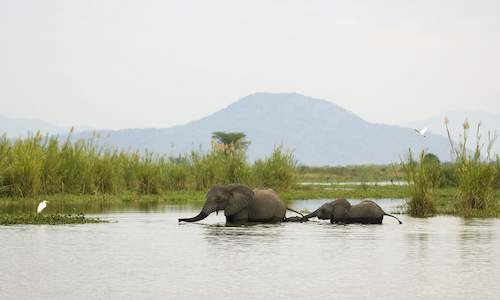
One of Malawi's top attractions, visitors should not miss the opportunity to spend some time hiking across the magnificent slopes of Mount Mulanje, the highest peak in Central Africa.
Central Africa's highest peakMount Mulanje is situated in the southern region of Malawi, on the border of Mozambique, near to the city of Blantyre. Mulanje is a large massif that stretches across 22x26 kilometres (13x16 miles) and climbs to a height of over 3 000 metres above sea level at it's highest peak; Sapita Peak.Lush Landscape
The incredible height of the peaks results in a disturbance of the upper level air flow resulting in rain clouds being formed and regular rain fall, making the peaks an important source of water for the region.The landscape of Mount Mulanje consists of lush green rolling peaks, covered in grassland and deep forest ravines that intersect across the slopes. The West face of the massif; named Chambe Peak, is the longest rock climb in Africa and reaches over 2 500metres in height.Looking into The Past
Formed over 130 million years ago, there is evidence to suggest that the mountain was inhabited by humans from as far back as the Stone Age. The first European to report seeing the mountain was David Livingstone in 1895.Flora and Fauna
The mountain is part of the Mulanje Forest Reserve, a reserve created to protect the native Mulanje Cypress (some of which are now over 200 years old) that has been heavily logged in the past.Aside from the endangered cypress, the wilderness park is also home to a variety of endemic plant and animal species including Forest Butterflies, Dwarf Chameleons, Geckos and birds such as the CholoAlethe and White-winged Apalis.Most Majestic Sight in Malawi

Hiking Guidelines
Visitors to the mountain and the forest reserve will need to obtain a permit and pay the hut fees prior to embarking on the hiking trails. For those wanting to explore the higher reaches, a mountain guide is compulsory and can be organised from a list at the Likabula Forest Station. Porters can also be organised from the station.When to Visit
The best time to visit the area is between April and August when the temperatures are moderate and the weather is dry.November to early April is usually very hot and wet and September and October are considered extremely hot and dry.It is typically colder or cooler on the mountain than at the base and visitors are advised to carry warm gear at all times. Visitors to the mountain should be prepared for sudden weather changes and should always hike in groups and advise someone of their route.
by Katie Edge

 Malawi also known as the Warm heart of Africa, is Widely renowned for its beach getaways on the shores of Lake Malawi. See Malawi safari tou...
Malawi also known as the Warm heart of Africa, is Widely renowned for its beach getaways on the shores of Lake Malawi. See Malawi safari tou...